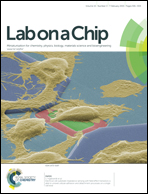FISH in chips: turning microfluidic fluorescence in situ hybridization into a quantitative and clinically reliable molecular diagnosis tool†
Abstract
Microfluidic systems bear promise to provide new powerful tools for the molecular characterization of cancer cells, in particular for the routine detection of multiple cancer biomarkers using a minute amount of the sample. However, taking miniaturized cell-based assays into the clinics requires the implementation and validation of complex biological protocols on chip, as well as the development of disposable microdevices produced at a low cost. Based on a recently developed microfluidic chip made of Cyclic Olefin Copolymer for cell immobilization with minimal dead volume and controlled shear stress, we developed a protocol performed entirely in the liquid phase, allowing the immobilization and fixation of cells and their quantitative characterization by fluorescence in situ hybridization. We demonstrated first in cell lines and then in two clinical case studies the potential of this method to perform quantitative copy number measurement and clinical scoring of the amplification of the ERBB2 gene, a decisive biomarker for the prescription of HER2+ related targeted therapies. This validation was performed in a blind protocol in two clinical case studies, in reference to the gold standard and clinically used method based on glass slides. We obtained a comparable reproducibility and a minor difference in apparent amplification, which can be corrected by internal calibration. The method thus reaches the standard of robustness needed for clinical use. The protocol can be fully automated, and its consumption of samples and DNA probes is reduced as compared to glass slide protocols by a factor of at least 10. The total duration of the assay is divided by two.


 Please wait while we load your content...
Please wait while we load your content...